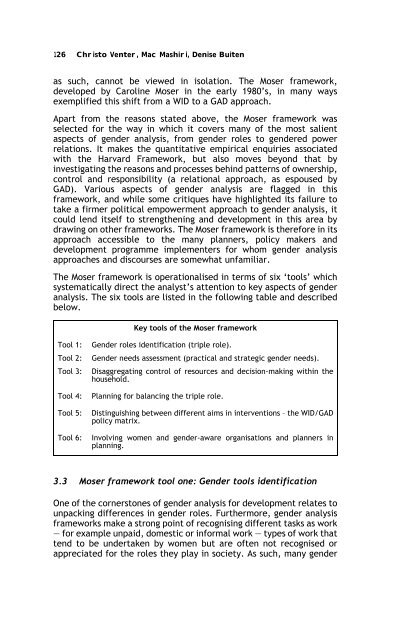Sex, Gender, Becoming - PULP
Sex, Gender, Becoming - PULP
Sex, Gender, Becoming - PULP
You also want an ePaper? Increase the reach of your titles
YUMPU automatically turns print PDFs into web optimized ePapers that Google loves.
126 Christo Venter, Mac Mashiri, Denise Buiten<br />
as such, cannot be viewed in isolation. The Moser framework,<br />
developed by Caroline Moser in the early 1980’s, in many ways<br />
exemplified this shift from a WID to a GAD approach.<br />
Apart from the reasons stated above, the Moser framework was<br />
selected for the way in which it covers many of the most salient<br />
aspects of gender analysis, from gender roles to gendered power<br />
relations. It makes the quantitative empirical enquiries associated<br />
with the Harvard Framework, but also moves beyond that by<br />
investigating the reasons and processes behind patterns of ownership,<br />
control and responsibility (a relational approach, as espoused by<br />
GAD). Various aspects of gender analysis are flagged in this<br />
framework, and while some critiques have highlighted its failure to<br />
take a firmer political empowerment approach to gender analysis, it<br />
could lend itself to strengthening and development in this area by<br />
drawing on other frameworks. The Moser framework is therefore in its<br />
approach accessible to the many planners, policy makers and<br />
development programme implementers for whom gender analysis<br />
approaches and discourses are somewhat unfamiliar.<br />
The Moser framework is operationalised in terms of six ‘tools’ which<br />
systematically direct the analyst’s attention to key aspects of gender<br />
analysis. The six tools are listed in the following table and described<br />
below.<br />
Key tools of the Moser framework<br />
Tool 1:<br />
Tool 2:<br />
Tool 3:<br />
Tool 4:<br />
Tool 5:<br />
Tool 6:<br />
<strong>Gender</strong> roles identification (triple role).<br />
<strong>Gender</strong> needs assessment (practical and strategic gender needs).<br />
Disaggregating control of resources and decision-making within the<br />
household.<br />
Planning for balancing the triple role.<br />
Distinguishing between different aims in interventions – the WID/GAD<br />
policy matrix.<br />
Involving women and gender-aware organisations and planners in<br />
planning.<br />
3.3 Moser framework tool one: <strong>Gender</strong> tools identification<br />
One of the cornerstones of gender analysis for development relates to<br />
unpacking differences in gender roles. Furthermore, gender analysis<br />
frameworks make a strong point of recognising different tasks as work<br />
— for example unpaid, domestic or informal work — types of work that<br />
tend to be undertaken by women but are often not recognised or<br />
appreciated for the roles they play in society. As such, many gender
















